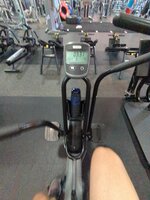I'm up to speed pretty good on this.
How did you derive that threshold on your heart rate scale? Let's assume some sort of metabolic testing. We also need to do cardiovascular fitness testing to determine heart rate/power output relationship. We can then look at that info to figure out the corresponding level of physical stress at which the body shifts from aerobic to anaerobic fuel sources. We hope to mostly fuel our racing on fat stores, which are processed with oxygen. If everything is being supplied with adequate oxygen, then we're satisfied the brain isn't getting any serious competition for it's share.
In terms of fitness, I want my drivers to be able to keep under the ventilatory threshold at all times when driving. That's roughly the level of physical exertion at which it becomes difficult to talk. If a driver is driving at that stress level for long enough, they *will* make a mistake. The heart rates we log in the car are not exactly representative of the heart rates we see on a bike or erg (rower). All produce elevated heart rates due to stress, but the tests are primarily due to physical exertion while the car example has a significant heat component. I think in both cases, though, the heart rate is representative of when stress hormones start being released and the body shifts from fat burning to glycolic systems.
So, when I say I don't want my drivers at the point where they are hitting the glycolic systems, it's because that represents a level of stress to which I don't want my driver's exposed. There's many ways of addressing this. The fitness of the driver is the most obvious. The higher a level of stress a driver can maintain before going over threshold will be the first thing to address. It can also mean the car is handling poorly. It's both mentally and physically fatiguing to constantly be correcting and catching the car. Having a good car takes a ton of stress off a driver. Heat is a big deal. If you can keep your driver cooler, you can keep your driver closer to their peak performance. It's often worth carrying a cool-box, even if it's a weight penalty, because the loss in performance due to the weight is significantly less than the loss of performance of the driver due to over-heating stress. There are many more factors at play.
The driver has to assume that they will be under some sort of heavy stress in a big race and will probably need to be able to access those glycogen reserves at different points. You can't use it if you don't have it, so a higher carb meal makes sense (even though you hope to not really have to use it). In my experience, the most common driver meal during long races is unbreaded chicken with either rice or pasta w/ olive oil or butter.
How did you derive that threshold on your heart rate scale? Let's assume some sort of metabolic testing. We also need to do cardiovascular fitness testing to determine heart rate/power output relationship. We can then look at that info to figure out the corresponding level of physical stress at which the body shifts from aerobic to anaerobic fuel sources. We hope to mostly fuel our racing on fat stores, which are processed with oxygen. If everything is being supplied with adequate oxygen, then we're satisfied the brain isn't getting any serious competition for it's share.
In terms of fitness, I want my drivers to be able to keep under the ventilatory threshold at all times when driving. That's roughly the level of physical exertion at which it becomes difficult to talk. If a driver is driving at that stress level for long enough, they *will* make a mistake. The heart rates we log in the car are not exactly representative of the heart rates we see on a bike or erg (rower). All produce elevated heart rates due to stress, but the tests are primarily due to physical exertion while the car example has a significant heat component. I think in both cases, though, the heart rate is representative of when stress hormones start being released and the body shifts from fat burning to glycolic systems.
So, when I say I don't want my drivers at the point where they are hitting the glycolic systems, it's because that represents a level of stress to which I don't want my driver's exposed. There's many ways of addressing this. The fitness of the driver is the most obvious. The higher a level of stress a driver can maintain before going over threshold will be the first thing to address. It can also mean the car is handling poorly. It's both mentally and physically fatiguing to constantly be correcting and catching the car. Having a good car takes a ton of stress off a driver. Heat is a big deal. If you can keep your driver cooler, you can keep your driver closer to their peak performance. It's often worth carrying a cool-box, even if it's a weight penalty, because the loss in performance due to the weight is significantly less than the loss of performance of the driver due to over-heating stress. There are many more factors at play.
The driver has to assume that they will be under some sort of heavy stress in a big race and will probably need to be able to access those glycogen reserves at different points. You can't use it if you don't have it, so a higher carb meal makes sense (even though you hope to not really have to use it). In my experience, the most common driver meal during long races is unbreaded chicken with either rice or pasta w/ olive oil or butter.














